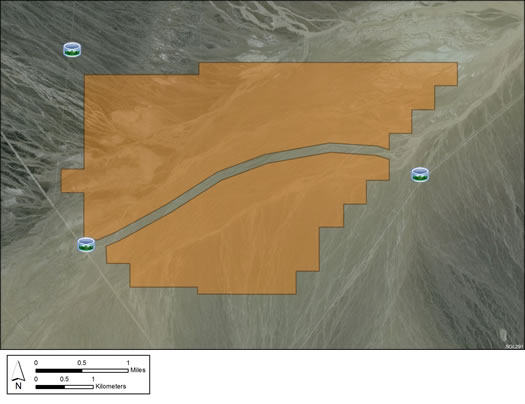The Approved Record of Decision for Resource Management Plan Amendments for Utility-Scale Solar Energy Development was issued on December 20th, 2024 — details are available on the BLM's Utility-Scale Solar Energy Development PEIS/RMPA webpage. Relevant information on the 2024 Western Solar Plan and the BLM's Renewable Energy Rule issued in July 2024, is in the process of being updated on this website.
| Nevada Variance Areas | Gold Point SEZ |
 |
 |
The Gold Point Solar Energy Zone (SEZ) is a designated leasing area (DLA) located in Nevada in the Lida Valley in an undeveloped rural area. The SEZ is located on BLM-administered land within the Battle Mountain District.
The Gold Point SEZ has a total area of 4,810 acres (19 km2). In the 2011 Supplement to the Draft Solar PEIS, 214 acres (0.87 km2) of a significant unnamed intermittent stream passing east-west through the center of the SEZ were identified as non-development areas, leaving the SEZ with a potentially developable area of 4,596 acres (18.6 km2). No additional changes to the SEZ developable area were made in the 2012 Final Solar PEIS.
The Gold Point SEZ is located in Esmeralda County in southwestern Nevada. The SEZ is located in Lida Valley, which lies between Mount Jackson Ridge and Cuprite Hills to the north, and Slate Ridge to the south. It is bounded on the west by Palmetto Mountains and on the east by Stonewell Mountains. In 2008, the county population of Esmeralda was 664, while adjacent Nye County to the east had a population of 44,175. There are no incorporated towns in close proximity to the SEZ, but the small community of Gold Point is located about 2 mi (3.2 km) south of the SEZ. The town of Tonopah is approximately 50 mi (80 km) to the north.

The Gold Point SEZ is in an undeveloped rural area, with very little topographic relief. Vegetation within the SEZ is predominantly scrubland, with shadscale, greasewood, and winterfat, with some Joshua trees. Playas occur in the northeast portion of the SEZ, and washes slope downward slightly from the southwest to northeast.
Lands within and near the SEZ contain dirt roads and vegetation. Part of the SEZ is authorized by the BLM for grazing. The SEZ may be have limited use by local residents for general outdoor recreation, including off-highway vehicle use.

The nearest major road access is State Route 774, which parallels the eastern edge of the SEZ; U.S. 95 passes within 9 mi (14 km) to the east of the SEZ. The nearest existing transmission line is a 345-kV north-south line located about 3 mi (5 km) east of the SEZ.
In the 2012 Solar PEIS, the BLM committed to establishing a monitoring and adaptive management strategy for each solar energy zone (SEZ). Through these strategies, the BLM will take an active role in the collection of baseline data for the SEZs.
The BLM has not yet begun the monitoring and adaptive management strategy for the Gold Point SEZ. However, the BLM has conducted a pilot monitoring and adaptive management strategy for the Riverside East SEZ. In May 2016, the BLM released the Riverside East Solar Energy Zone Long Term Monitoring Strategy Final Report. The monitoring strategy document (PDF, 16.6 MB) is now available.
In the 2012 Solar PEIS, the BLM committed to preparing solar regional mitigation strategies (SRMSs) for the solar energy zones (SEZs). These regional mitigation strategies were intended to simplify and improve the mitigation process for future solar projects in SEZs.
SRMSs have been completed for two Nevada SEZs (Dry Lake and Dry Lake Valley North), but not for the Amargosa Valley, Gold Point, or Millers SEZs in NV. With IM-2019-018, the BLM established policy that compensatory mitigation could not be required as a condition for project approvals. However, with the issuance of IM 2021-038 on July 14, 2021, the BLM rescinded the previous IM-2019-018. The BLM expects to establish policies which are aligned with EO 13990, SO 3398, and the priorities of the Department. During this interim period offices should consider and implement compensatory mitigation on a case-by-case basis, in consultation with state office and national office program specialists and the Office of the Solicitor as needed.